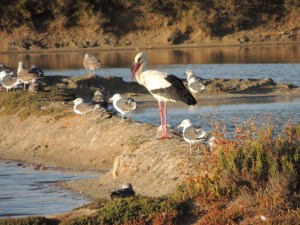
Ciconia ciconia may be a very common sight for those who live in Africa or on mainland Europe but for us Brits living on that island called the United Kingdom the White Stork is something to behold. It is a rare sight in the United Kingdom now, but I suspect nearly everyone recognises it because of the many myths and folktales about Storks. Which probably explains why you will spot us all taking photographs of them when we see them on their nests on top of chimneys or soaring above us on a thermal. After three years of regular stays in Olhão I still cannot resist taking a photograph of them!

 The Iberian Peninsula is a stronghold for the White Storks, and you will regularly see them in
The Iberian Peninsula is a stronghold for the White Storks, and you will regularly see them in  the open grasslands and wetlands. They are not difficult to spot as they are big birds – adults between 3ft and 4ft in height and a length of 3ft. Their wing span is even bigger; up to 7ft. They are as their name suggests mostly white, although on wet days it looks more grey or brown following a forage in the mud! The adults have red beaks, black flight feathers and bright red legs; the latter though again is dependent upon the mud.
the open grasslands and wetlands. They are not difficult to spot as they are big birds – adults between 3ft and 4ft in height and a length of 3ft. Their wing span is even bigger; up to 7ft. They are as their name suggests mostly white, although on wet days it looks more grey or brown following a forage in the mud! The adults have red beaks, black flight feathers and bright red legs; the latter though again is dependent upon the mud.

Occasionally it will be the noise of them that attracts you before a sighting; bill-clattering. They make this incredible noise by opening and closing their bills rapidly, which they then seem to amplify in their throats as they move their heads to and fro.

Most guides I have read advise that they fly south for the Winter to Africa, we however have seen them year round in the Algarve a behavioural trait which would appear to have developed in the past 20years or so.

 Despite their height they don’t look incongruous on top of their nests in fact on returning to England our chimneys look naked without them.
Despite their height they don’t look incongruous on top of their nests in fact on returning to England our chimneys look naked without them.  As well as chimneys you will see the nests on Church roofs, trees, specially built posts and walls of abandoned buildings. There are is chimney in Olhão which doesn’t have nests but this Spring did have a pair of Storks regularly visiting. I can only assume there is something wrong with the chimney, although having said that there is chimney just round the corner whichs look very precarious with a Stork and nest on it.
As well as chimneys you will see the nests on Church roofs, trees, specially built posts and walls of abandoned buildings. There are is chimney in Olhão which doesn’t have nests but this Spring did have a pair of Storks regularly visiting. I can only assume there is something wrong with the chimney, although having said that there is chimney just round the corner whichs look very precarious with a Stork and nest on it.

I was not surprised to learn that their nests are full of mites, they use the same nests year after year just updating it with a few sticks. Some nests have been there for decades, if not longer. If you look carefully at the larger nests you will notice they are also home to many sparrows. I am guessing that the sparrows nest out of beak reach though as they are the perfect size for a Stork meal.

As well as small birds, Storks eat beetles, grasshoppers, earthworms, mammals, frogs, fish and crustaceans. They usually forage not far from their nests.

I’m not the only one who thinks they are wonderful, check out this poem Ciconia Ciconia by Michael Waters.
Great pics. I see them at Parc Ornithologique du Teich, Bassin D’Arcachon , NW France. It was there 2 yrs ago I was transfixed by a nightingale singing a few yards from me. I have a blog about the experience.
Thanks. And wow about the nightingale – never seen one. Will go and look at your blog.